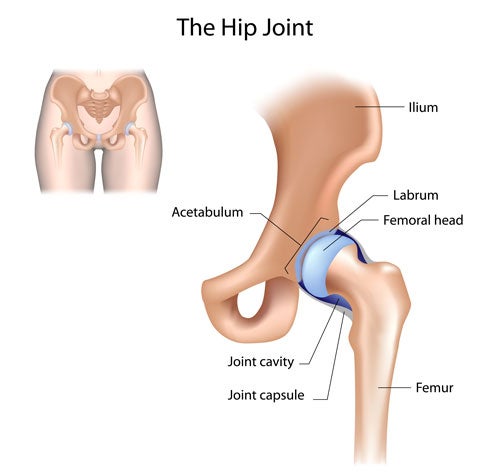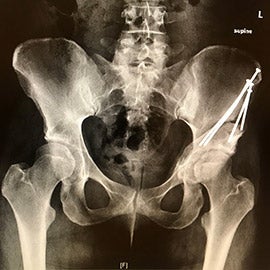
When you envision someone needing hip surgery, who do you see? Are you seeing a young woman her 20s? Probably not, but this is actually the typical age of someone who needs a periacetabular osteotomy (PAO) for hip dysplasia or hip preservation surgery. For Kerrianne McMenimon, a 25-year-old nurse and mother, this was just the treatment that she needed to overcome chronic hip pain and improve her quality of life.

Figure: Hip Joint graphic
Kerrianne began to notice some hip pain in 2013 when she was 20, in 2015 her primary care provider diagnosed her with hip dysplasia. Hips support body weight and give you the ability to walk, sit, and move around regularly. Hip dysplasia is a condition where the hip’s ball (femoral head) and socket (acetabulum) do not line up correctly.
Having hip dysplasia can cause the degeneration, or wearing out, of the hip joint faster than someone who does not have hip dysplasia. Most people are born with hip dysplasia and it is the most common developmental hip deformity in children and the most common cause of hip arthritis in adults.
In October 2016, Kerrianne gave birth to her son. “Towards the end of my pregnancy, my hip was very painful,” says Kerrianne. “I was only 24 years old and knew that this wasn’t normal.” At this point, the pain at the front of her leg down to her knee was making it difficult to walk. Physical therapy was not helping so Kerrianne made an appointment with an orthopedic surgeon, who referred her to BMC orthopedic surgeon and hip dysplasia specialist, Michael Kain, MD.

An X-ray image of Kerrianne’s hip, post-surgery.
The decision to have PAO to correct hip dysplasia is a collaborative one between the surgeon and the patient. They need to have an open discussion about what their goals are for surgery. For Kerrianne, who wanted to be able to keep up with her young son and effectively work as a nurse without pain, this surgery was the right option for her. During the surgery, the surgeon makes four cuts in the pelvic bone around the hip joint to loosen the acetabulum. Then, they rotate the acetabulum, repositioning it into a more normal anatomic position over the femoral head. The doctor will use x-rays to ensure that the acetabulum is repositioned correctly. Once the bone is repositioned, the doctor inserts several small screws to hold it in place until it heals. In most cases, PAO takes from 2-3 hours to perform.
This is a serious surgery. Kerrianne was in the hospital for six days. “I needed help moving around the first couple of days, but the nurses were helpful and my care team helped manage my pain,” recalls Kerrianne. “Kerrianne and I worked together to achieve her goals, which included reducing her pain and improving her quality of life,” says Dr. Kain. “By improving her hip mechanics through PAO, she will have improved function and a healthier hip.”

Kerrianne with her son.
After returning home, Kerrianne used a walker and crutches to move around, then just crutches at week nine to only using one crutch at week 16. She had support to help care for her son and began going to outpatient therapy appointments eight weeks after her surgery. She still works on strength and flexibility of her new hip, but is happy to report that the joint pain is gone. She has since returned to working as a nurse, a physically demanding job and is grateful for her improved quality of life. She is especially grateful that she will not be needing a total hip replacement by age 30.
Do you have chronic hip pain? Make an appointment today 617.638.5633. BMC.org/orthopedic-surgery
###
